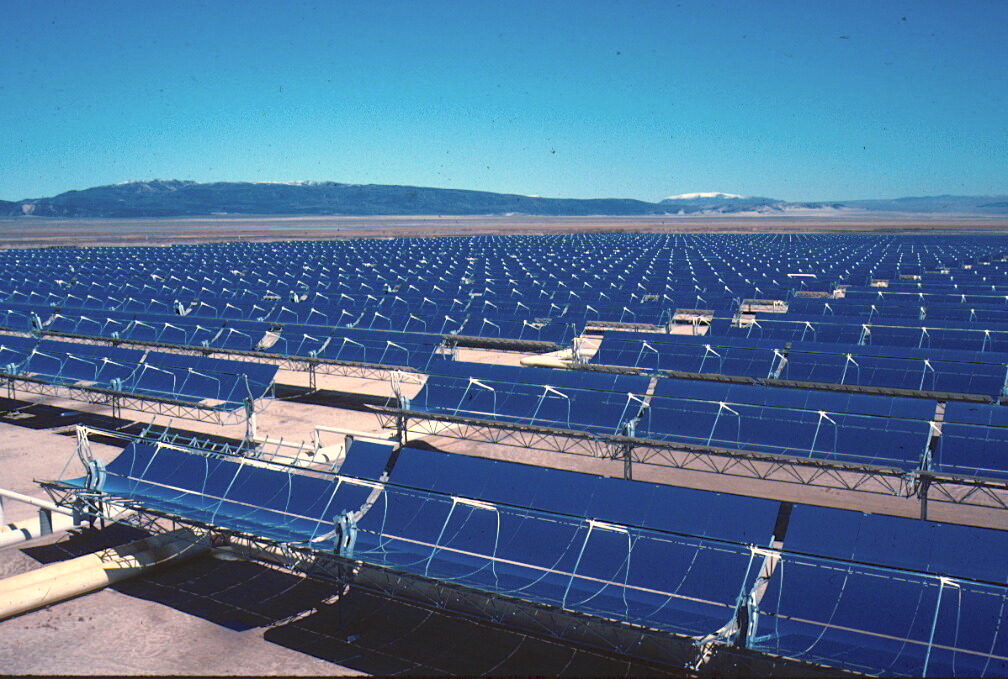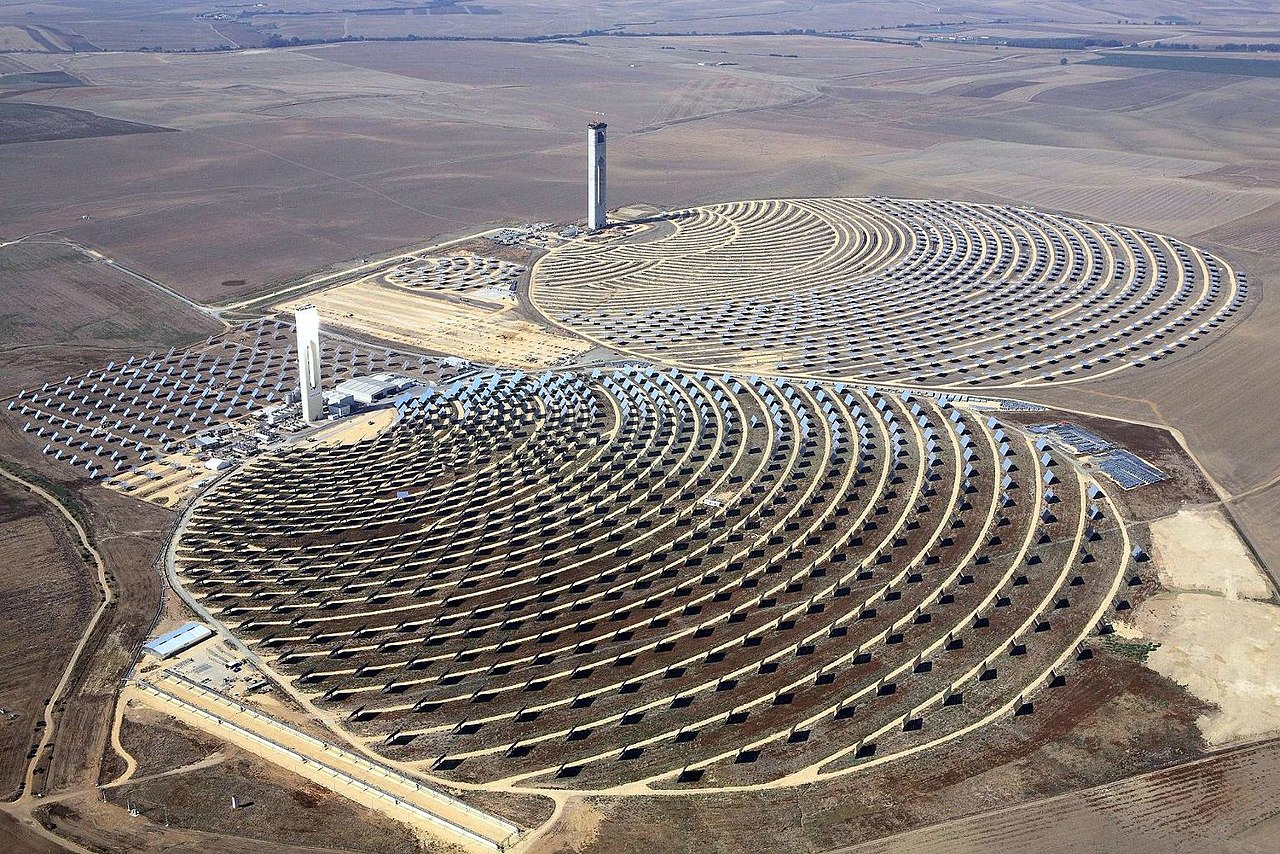Solar Energy: Utility Scale
In this discussion we will focus on other (besides PV) utility scale processes for harvesting solar energy. We will also address the questions of biofuels and biomass as potential sources of energy.
Applying Previous Processes:
Multiple times during the previous weeks we have calculated the power density (W/m2) of a particular process as well as the meaning and use of the capacity factor. As a reminder:
Capacity Factor: The percent of the nameplate or installed capacity that is actually used. Multiply the nameplate capacity by the capacity factor to get actual power generation (W, kW, MW).
Power Density: Most renewable energy sources use relatively large amounts of space. The actual power production divided by the area of the energy generation installation gives us W/m2. Note to self -- it is common of forget to convert squared units correctly. It takes two (2) conversion factors to convert squared unit.

Trough collectors are a way of indirectly generating electricty by concentrating sunlight to raise the temperature of a working fluid (usually a high temperature oil) well above the boiling point of water. Sometimes these cylindrical mirrors are oriented E-W and only adjusted slowly to accomodate the seasons. Other times they are oriented N-S and track the sun every day. For various reasons these installations tend to be large scale and are not generally suitable for homes.
The data on the wiki site references the nameplate capacity, the capacity factor, and the total area.
Activity: In your group calculate the power density (W/m2) of this solar trough facility.
We'll talk about your results a little before moving on to a new question about energy generation systems both large and small.
HW: Solar Utilities
Here is the wiki page for Nevada Solar One, a solar trough collector in the US. Using the data you find on this wiki page determine the power density AND the installation cost per watt as we have done throughout this page.
Cost/MW Installed Capacity:
As we have been digging deeper into each of these methods for generating energy a question we have been ignoring is the cost. It is important to note that our primary goal is to determine if renewable energy CAN meet our energy needs before worrying about what it might cost. Given that we have seen that the cost of wind energy is now competive with more traditional sources of energy it seems prudent to start considering the cost of these new energy generation technologies.
The most common approach to describing the cost is to consider the cost for each MW of installed capacity. Regardless of the capacity factor this is what an energy company will have to pay to build an energy generation facility of some size.
Wind:
For reference lets start with wind where we already have the numbers from a previous discussion. A 2.5 MW wind turbine costs about 3-4 M$. That puts the cost/MW at around 1.3-1.5 M$/MW or $1.30 to $1.60/W.
Traditional Energy Generation:
This webpage from the US Energy Information Administration gives us a sense of installation costs for more traditional sources of energy like natural gas. They list wind at $1400/kW or $1.40/W which matches our previous value. Natural gas is listed at $840/kW or $0.84/W. This is a useful point of comparison.
Solar Trough:
Looking back at the Andasol project in Spain the first 50 MW cost about 380M$ (US) to build. That is about $7.50/W which is quite a bit more expensive. It is probably important to note that solar trough technology hasn't had as much time to realize manufacturing economies since there are still relatively few of these projects. If you read in the details you can see that there is a financial incentive for this project which is equal to the projected cost for each kWh. That makes it cost effective for the builder/owner but not so much for the society as a whole.

The tower of power is another form of indirect electricity generation. One challenge with the solar trough collectors is that the curved mirrors are a bit of a technical challenge to make. The tower of power uses simple flat mirrors to concentrate the sun's energy and heat a fluid in much the same way. The extra challenge in a tower of power set up is that the temperatures at the focal point are extreme which PS20 (and PS10 it's precursor) is an example of such a system in Spain.
There is an interesting, though probably untrue, story that Archimedes was the first to try and use the sun this way by lining up Greek soldiers with their polished bronze shields to concentrate the sun on an enemy fleet and set it on fire. Here is a more reasoned analysis of this story which descibes modern, unsuccessful, attempts to replicate the legendary event.
Activity: In your group calculate the power density and the cost/MW for this tower of power facility. The area of this facility is not given in the wiki page so I went to google maps and measured it and the array of mirrors is effectively 1000 m x 1000 m. It was also hard to find a cost for this project but eventually I found it in a report at 100M$ for the 20 MW project.
HW: Solar Utilities
Here is the wiki page for Ivanpah Solar Power Facility, a tower of power collector in the US. Using the data you find on this wiki page determine the power density AND the installation cost per watt as we have done throughout this page.
2022 Update:
A quick check suggests that costs for both of these systems have come down to around 7 $/W of installed capacity. Optimistic models hope that we might drop that to around 2.50 $/W by 2030. This looks like these technologies are going to be more expensive for some time.
Biomass from Solar:
This is a bit more complex calculation but lets start by remembering that, depending on where you live, the solar energy that is available to convert to energy is between 150 W/m2 along the coasts up to 300 W/m2 in Arizona. If we take the average available solar energy in the corn belt to be 200 W/m2 then we can ask how much corn we can grow with that energy (and some water and fertilizer). A quick data search suggests that an average yield is 190 bushels/acre. From each bushel we can get almost 3 gallons of ethanol. Since 2.5 acres is 1.104 m2 we can put this all together to get....
gallons of ethanol/1.104 m2 = 190 bushels/acre x 2.5 acres/1.104 m2x 3 gallons ethanol/bushel
or 1.4.103 gal/104 m2 = .14 gal ethanol/m2
Ethanol has an energy density of roughly 22 kWh/gal. What we are looking for is the power density but my units are kWh which is energy. The hidden factor is that this crop is an annual crop so the .14 gal/m2 is generated over an entire year. That means that...
energy generated/m2 /year = .14 gal ethanol/m2/yr x 22 kWh/gal ethanol = 3 kWh/m2/yr
power density(W/m2) = 3 kWh/m2/yr x (1 yr/8760 h) = .34 W/m2
assuming the cost of fertilizer, fuel, and processing cuts that in half the power density for corn = .17 W/m2
This is a very low efficiency but it matches David's number pretty well. It's true that we can, and do, use ethanol to replace some of our petroleum use but the number above points out that we use a great deal of land to do it and an electric vehicle could use energy generated on 1/40th of the same area. This is what leads David to his conclusion that biomass as a source of energy is just not going to solve the problem for anybody.
HW: Solar Utilities
This is the same problem we just did but with different crops.....go slow and be sure to track the units from what you know (kg of oil/m2) to where you are going which is kWh/m2 annually. So here are some ag figures for biofuels production. In the Columbia basin one can harvest 2500 kg of canola seed per acre from an irrigated field in the spring. An acre is 4050 m2. The 2500 kg of canola seed will produce 1000 kg of canola oil which has an energy density of 11 kWh/kg. How many kWh/m2 are being generated annually from this crop? This is the annual production of canola oil so we can make the same assumptions we did with the corn to calculate the power density (W/m2) for canola oil. This number should be less than 2 W/m2 to be consistent with our text.
Assignment: HW: Solar Utilities
Complete and assemble your solutions to all the HW problems (2) listed here showing all the steps in your solutions. Scan to a pdf and turn in on LMS. Please review HW format expectations for guidance about your homework solutions.of
Reading Ahead:
Next class we will take the tools we have developed in our discussions of solar energy and look at how they apply to our individual lives. No new reading for this section.
